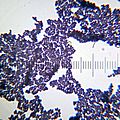Staphylococcus facts for kids
Quick facts for kids Staphylococcus |
|
|---|---|
 |
|
| This picture shows clumps of Staphylococcus aureus bacteria. | |
| Scientific classification | |
| Kingdom: | |
| Phylum: | |
| Class: | |
| Order: | |
| Family: | |
| Genus: |
Staphylococcus
Rosenbach 1884
|
Staphylococcus (say: Staff-ill-oh-KOK-us) is a type of tiny living thing called bacteria. These bacteria are so small you need a microscope to see them!
Their name comes from two old Greek words. Staphylē means "bunch of grapes," and kókkos means "granule" or "berry." If you look at them under a microscope, you'll see why. They are round, like tiny balls, and they often grow in clusters that look like a bunch of grapes.
Contents
What are Staphylococcus?
Staphylococcus bacteria are known as "gram-positive" bacteria. This is a scientific way to describe how their cell walls are built. Scientists use a special stain called Gram stain to tell different types of bacteria apart.
There are at least 40 different kinds, or species, of Staphylococcus. Some of these species even have smaller groups called subspecies.
Where do they live?
Most Staphylococcus bacteria are harmless. They often live on the skin and inside the nose of humans and other animals without causing any problems. They are a normal part of our bodies!
You can find these bacteria all over the world. They are also a small part of the tiny living things found in soil.
Are all Staphylococcus bad?
Most types of Staphylococcus are completely harmless. They live peacefully on our bodies. However, a few types can sometimes cause problems if they get into the wrong place, like a cut or inside the body.
One well-known type is Staphylococcus aureus. While it often lives harmlessly on skin, it can sometimes cause infections. But don't worry, scientists and doctors know how to treat these infections.
More about Bacteria
Bacteria are single-celled organisms. They are some of the oldest and smallest forms of life on Earth. They live almost everywhere: in soil, water, air, and even inside our bodies.
Most bacteria are helpful or harmless. For example, some bacteria help us digest food in our stomachs. Others help clean up pollution or make food like yogurt and cheese.
Images for kids
Related pages
See also
 In Spanish: Staphylococcus para niños
In Spanish: Staphylococcus para niños


